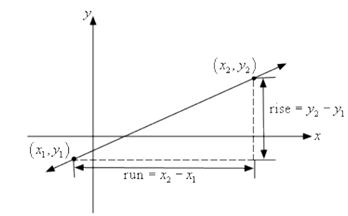One of the more significant ideas that we'll be discussing in this section is slope. The slope of a line is a measure of the steepness of any particular line and it can also be utilized to measure whether a line is increasing line or decreasing line as we move from left to right. Here is the particular definition of the slope of a line.
Specified any two points on the line say, ( x1 , y1 ) and ( x2 , y2 ) , the slope of the line is given by,
m = y2 - y1 /x2 - x1
In other terms, the slope is the difference in the y values divided by the difference in the x values. Also, do not get worried regarding the subscripts on the variables. These are utilized fairly regularly from this point on & are simply utilized to indicate the fact that the variables are both x or y values but are, in all probability, different.
While using this definition do not worry regarding which point must be the first point and which point must be the second point. You can select either to be the first and/or second and we'll get exactly the similar value for the slope.
There is also a geometric "definition" of the slope of the line as well. You will frequently hear the slope as being described as follows,
m = rise/ run
The two definitions are alike as the following diagram shown. The numerators & denominators of both definitions are the similar.

Notice as well that if we have the slope (written as a fraction) & a point on the line, say ( x1 , y1 ) , then we can determine a second point easily which is also on the line. Before seeing how it can be done let's take the convention that if the slope is -ve we will put the minus sign on the numerator of the slope. In other terms, we will suppose that the rise is negative if the slope is negative.
Note as well that a negative rise is actually a fall.
Thus, we have the slope, written as a fraction, and a point on the line, ( x1 , y1 ) . To get the coordinates of the second point, ( x2 , y2 ) all that we have to do is start at ( x1 , y1 ) then move to the right by the run (or denominator of the slope) and then up/down by rise (or the numerator of the slope) based on the sign of the rise. We can also write down some of equations for the coordinates of the second point as follows,
x2 = x1 + run
y2 = y1 + rise
Note that if the slope is -ve then the rise will be a negative number. Let's calculate a couple of slopes.